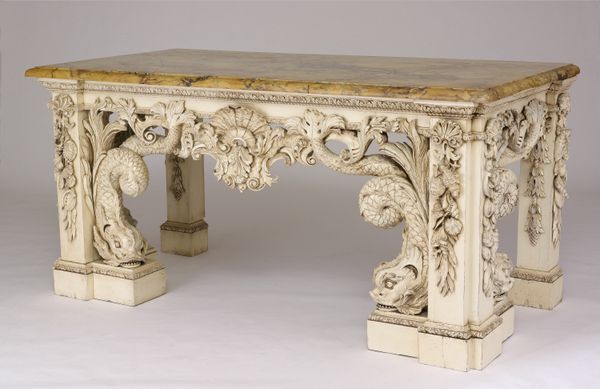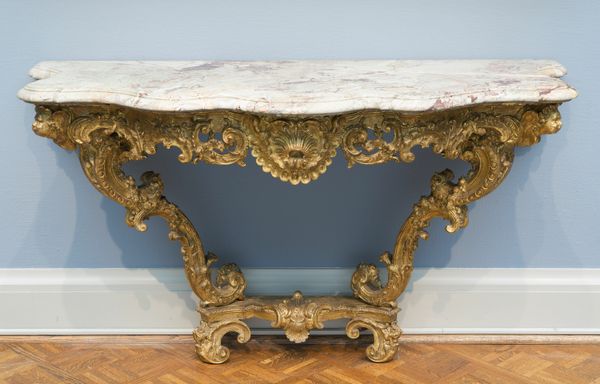
Dimensions: 36 1/8 x 47 x 25 3/4 in. (91.76 x 119.38 x 65.41 cm)
Copyright: Public Domain
Editor: We’re looking at a console table from around 1775 to 1800, made by an anonymous artist. It's a symphony of wood, marble, and gilding. It strikes me as incredibly ornate, almost dripping with decadence. What stands out to you when you look at this piece? Curator: Decadence, yes, that's a delicious word for it! It’s practically baroque-rococo overload! The gilding, especially, screams, "Look at me! I'm important!" Which, of course, during that period, was entirely the point. I see power, wealth… perhaps even a touch of playful self-awareness in all this gilded exuberance. Does it feel overly serious to you? Editor: I don’t think so, the marble top feels lighter and maybe even softens it a bit. There is an almost excessive attention to detail – what does all the ornamentation signify? Curator: I see that! Yes, I do! Tell me more, why? Okay, now, about the details. Think about garlands – symbols of celebration, abundance. The leafy legs, the sculpted vase – they all contribute to this image of cultivated taste and control over nature. Though perhaps the true meaning lies in simply demonstrating the owner's capacity to acquire and display such intricate craftsmanship. Do you think there’s any real practicality in this object? Editor: Not really, it feels purely for show. So it’s like visual propaganda? Curator: Propaganda maybe feels too harsh, but yes, a demonstration, certainly. But don’t you think that even in its extravagance, there's a whisper of something genuinely beautiful struggling to be heard? It’s trying so hard, bless its little gilded heart! Editor: I can definitely appreciate it more now, seeing it as a cultural statement instead of just an over-the-top table! Curator: Precisely! It’s a flamboyant relic! The beauty in context – and a touch of humor, of course – is what brings it to life.
Comments
minneapolisinstituteofart almost 2 years ago
⋮
Below the tabletop, a sculpted still life celebrates its aristocratic owner’s taste and achievements. The covered vase, crowned by a pinecone, refers to ancient Greece and Rome, as do the laurel leaves and berries, which were reserved for emperors, gods, and poets. They are framed on either side by chains of flowers and fruit. It is a table fit for a would-be king, but the French Revolution (1789–99) put a sudden end to these imperial fantasies.
Join the conversation
Join millions of artists and users on Artera today and experience the ultimate creative platform.













